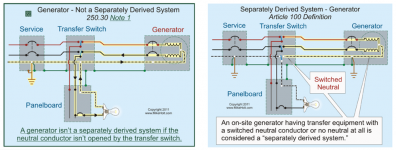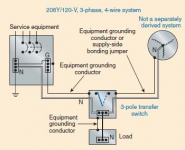Seven-Delta-FortyOne
Goin’ Down In Flames........
- Location
- Humboldt
- Occupation
- EC and GC
I’m having a serious mental block about this right now, and I even drew out a diagram amd I still can’t answer my question.
If you have a generator with a bonded neutral, and you use it for standby power, I know it’s a Code violation. I’m not wondering about that.
But I’m having trouble seeing where the multiple return paths would be. Suppose a pretty standard setup with a power inlet box right next to the panel, usually PVC nipple, and a flexible genny cord.
Even in a ground fault condition, I don’t see why fault current would go anywhere but directly back to the source, which is the generator.
What am I missing here?
If you have a generator with a bonded neutral, and you use it for standby power, I know it’s a Code violation. I’m not wondering about that.
But I’m having trouble seeing where the multiple return paths would be. Suppose a pretty standard setup with a power inlet box right next to the panel, usually PVC nipple, and a flexible genny cord.
Even in a ground fault condition, I don’t see why fault current would go anywhere but directly back to the source, which is the generator.
What am I missing here?



